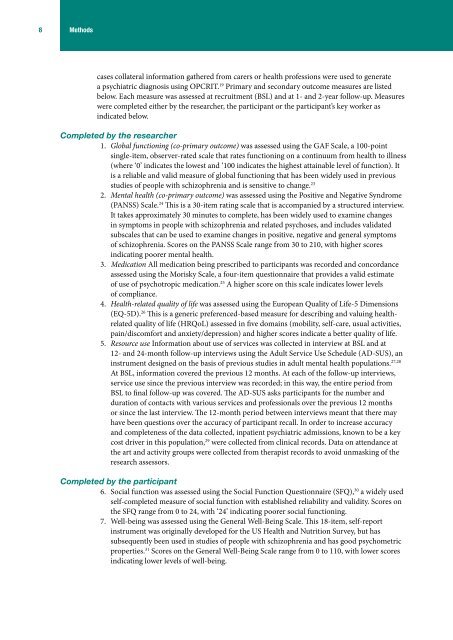a randomised controlled trial (MATISSE). - ResearchGate
a randomised controlled trial (MATISSE). - ResearchGate
a randomised controlled trial (MATISSE). - ResearchGate
Create successful ePaper yourself
Turn your PDF publications into a flip-book with our unique Google optimized e-Paper software.
8 Methods<br />
cases collateral information gathered from carers or health professions were used to generate<br />
a psychiatric diagnosis using OPCRIT. 19 Primary and secondary outcome measures are listed<br />
below. Each measure was assessed at recruitment (BSL) and at 1- and 2-year follow-up. Measures<br />
were completed either by the researcher, the participant or the participant’s key worker as<br />
indicated below.<br />
Completed by the researcher<br />
1. Global functioning (co-primary outcome) was assessed using the GAF Scale, a 100-point<br />
single-item, observer-rated scale that rates functioning on a continuum from health to illness<br />
(where ‘0’ indicates the lowest and ‘100 indicates the highest attainable level of function). It<br />
is a reliable and valid measure of global functioning that has been widely used in previous<br />
studies of people with schizophrenia and is sensitive to change. 23<br />
2. Mental health (co-primary outcome) was assessed using the Positive and Negative Syndrome<br />
(PANSS) Scale. 24 This is a 30-item rating scale that is accompanied by a structured interview.<br />
It takes approximately 30 minutes to complete, has been widely used to examine changes<br />
in symptoms in people with schizophrenia and related psychoses, and includes validated<br />
subscales that can be used to examine changes in positive, negative and general symptoms<br />
of schizophrenia. Scores on the PANSS Scale range from 30 to 210, with higher scores<br />
indicating poorer mental health.<br />
3. Medication All medication being prescribed to participants was recorded and concordance<br />
assessed using the Morisky Scale, a four-item questionnaire that provides a valid estimate<br />
of use of psychotropic medication. 25 A higher score on this scale indicates lower levels<br />
of compliance.<br />
4. Health-related quality of life was assessed using the European Quality of Life-5 Dimensions<br />
(EQ-5D). 26 This is a generic preferenced-based measure for describing and valuing healthrelated<br />
quality of life (HRQoL) assessed in five domains (mobility, self-care, usual activities,<br />
pain/discomfort and anxiety/depression) and higher scores indicate a better quality of life.<br />
5. Resource use Information about use of services was collected in interview at BSL and at<br />
12- and 24-month follow-up interviews using the Adult Service Use Schedule (AD-SUS), an<br />
instrument designed on the basis of previous studies in adult mental health populations. 27,28<br />
At BSL, information covered the previous 12 months. At each of the follow-up interviews,<br />
service use since the previous interview was recorded; in this way, the entire period from<br />
BSL to final follow-up was covered. The AD-SUS asks participants for the number and<br />
duration of contacts with various services and professionals over the previous 12 months<br />
or since the last interview. The 12-month period between interviews meant that there may<br />
have been questions over the accuracy of participant recall. In order to increase accuracy<br />
and completeness of the data collected, inpatient psychiatric admissions, known to be a key<br />
cost driver in this population, 29 were collected from clinical records. Data on attendance at<br />
the art and activity groups were collected from therapist records to avoid unmasking of the<br />
research assessors.<br />
Completed by the participant<br />
6. Social function was assessed using the Social Function Questionnaire (SFQ), 30 a widely used<br />
self-completed measure of social function with established reliability and validity. Scores on<br />
the SFQ range from 0 to 24, with ‘24’ indicating poorer social functioning.<br />
7. Well-being was assessed using the General Well-Being Scale. This 18-item, self-report<br />
instrument was originally developed for the US Health and Nutrition Survey, but has<br />
subsequently been used in studies of people with schizophrenia and has good psychometric<br />
properties. 31 Scores on the General Well-Being Scale range from 0 to 110, with lower scores<br />
indicating lower levels of well-being.
















